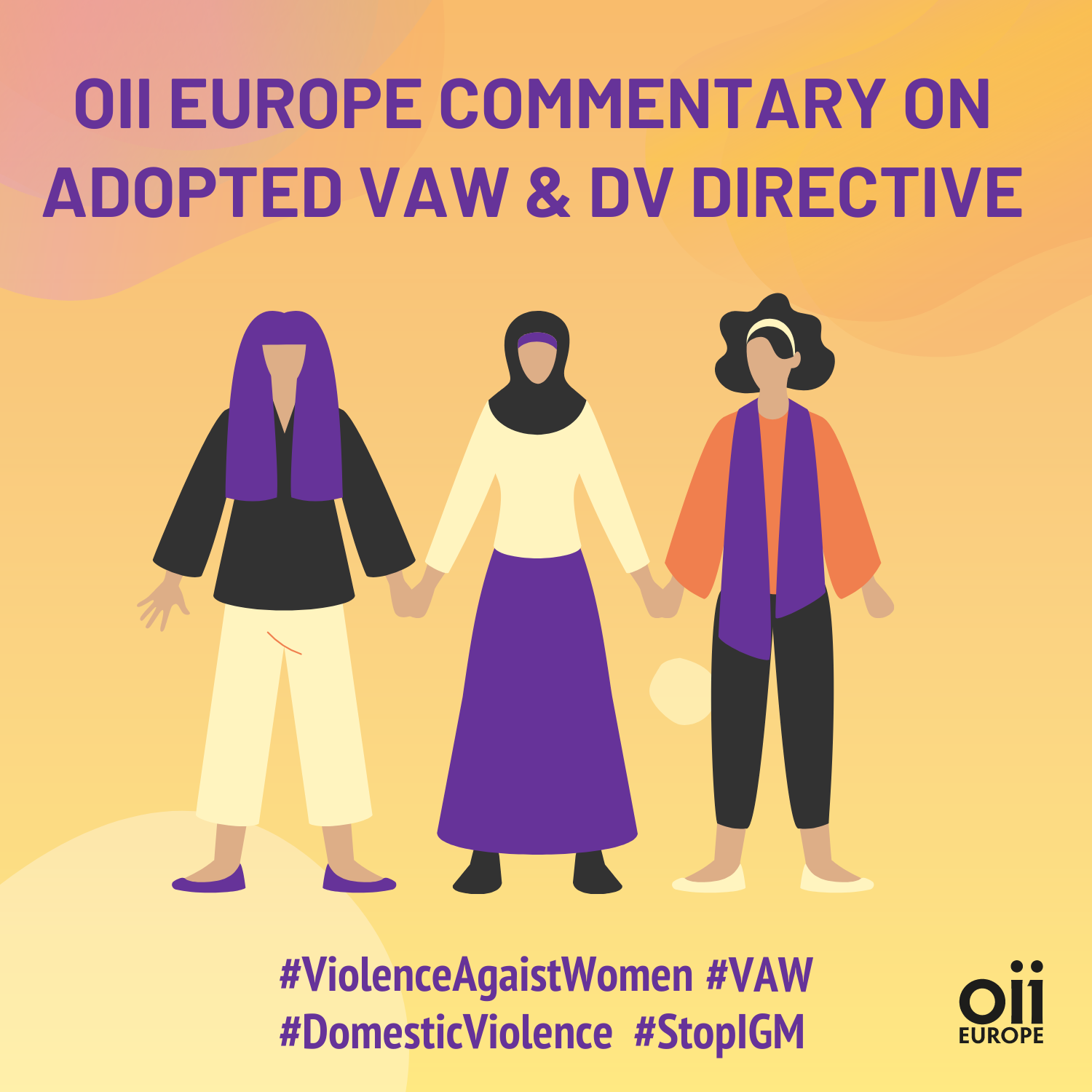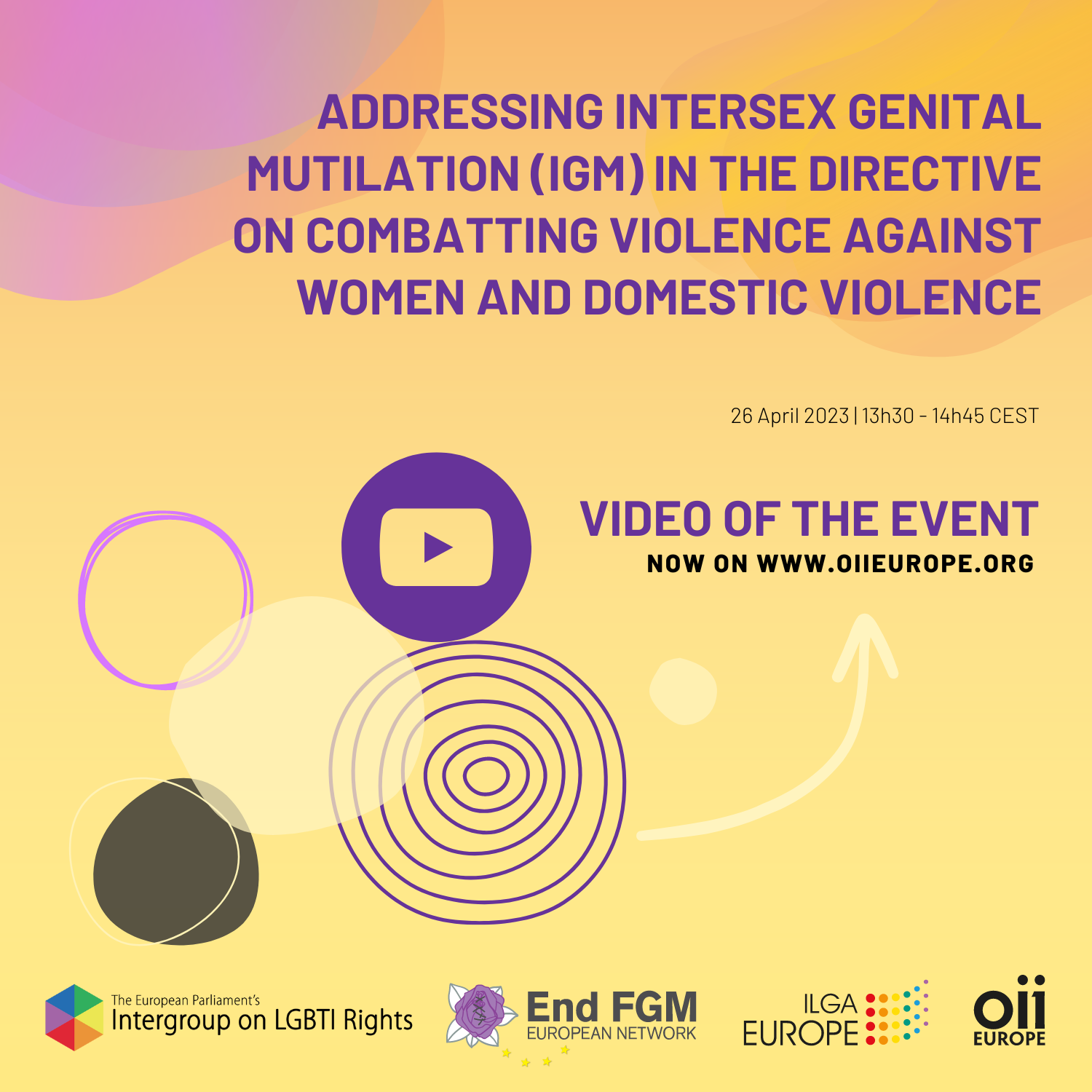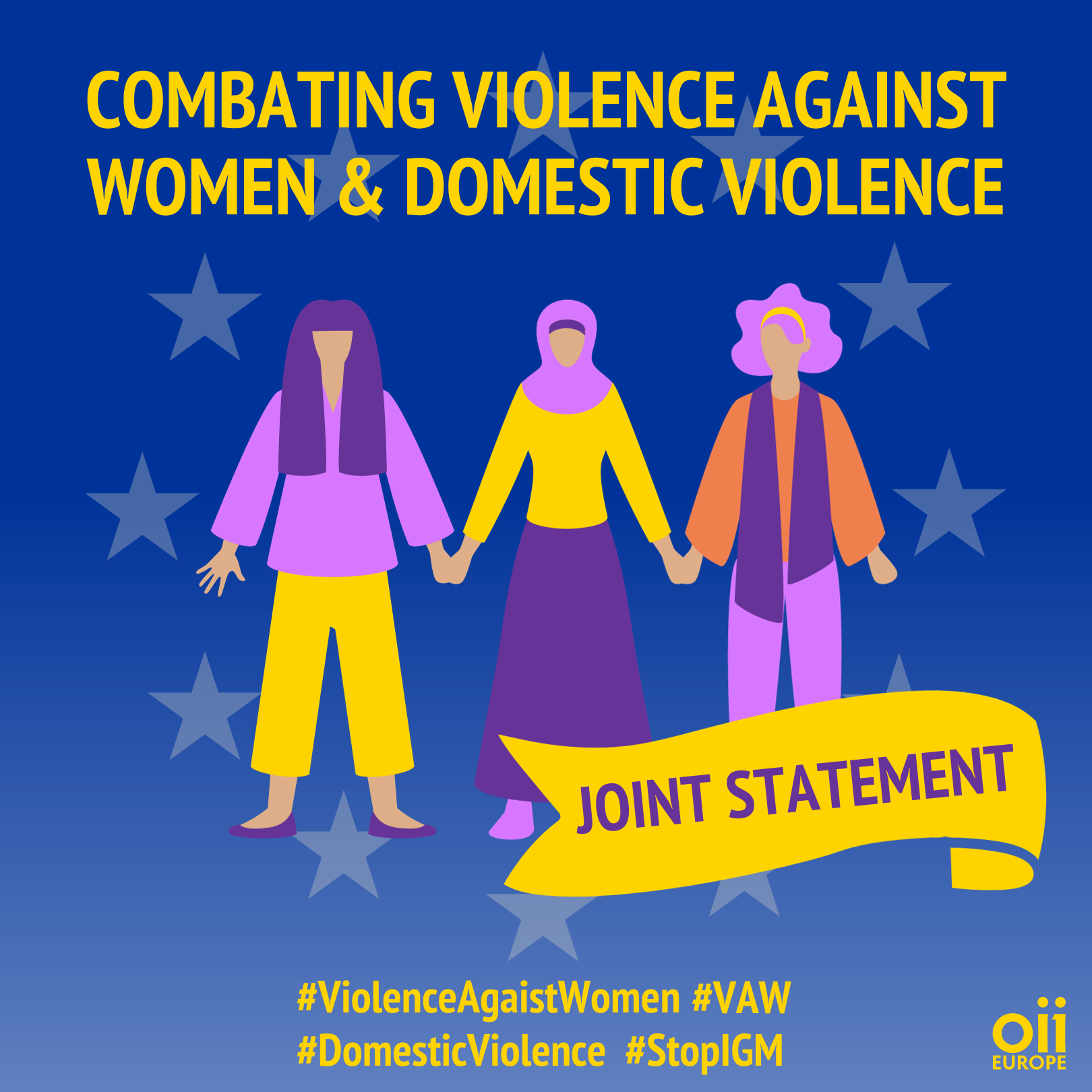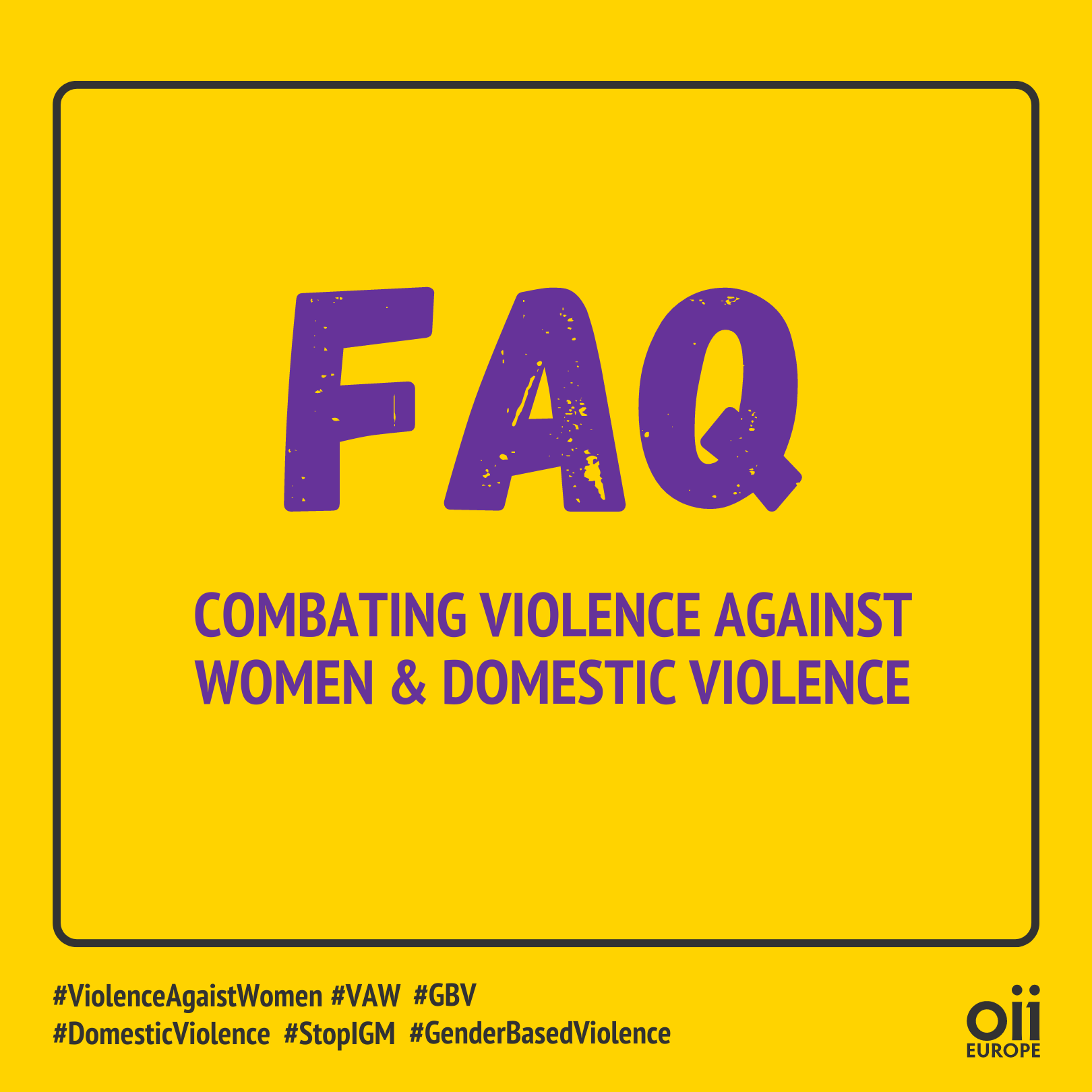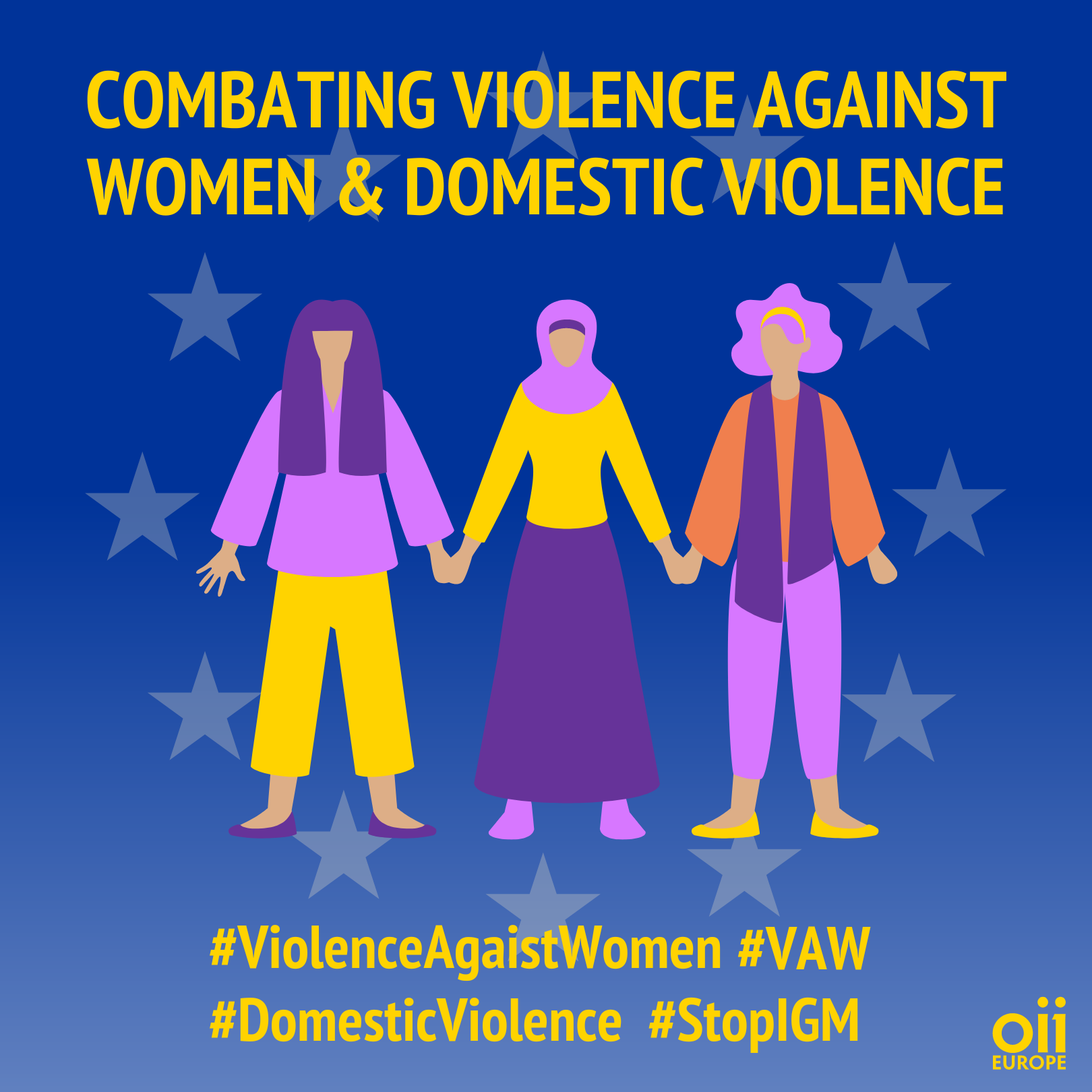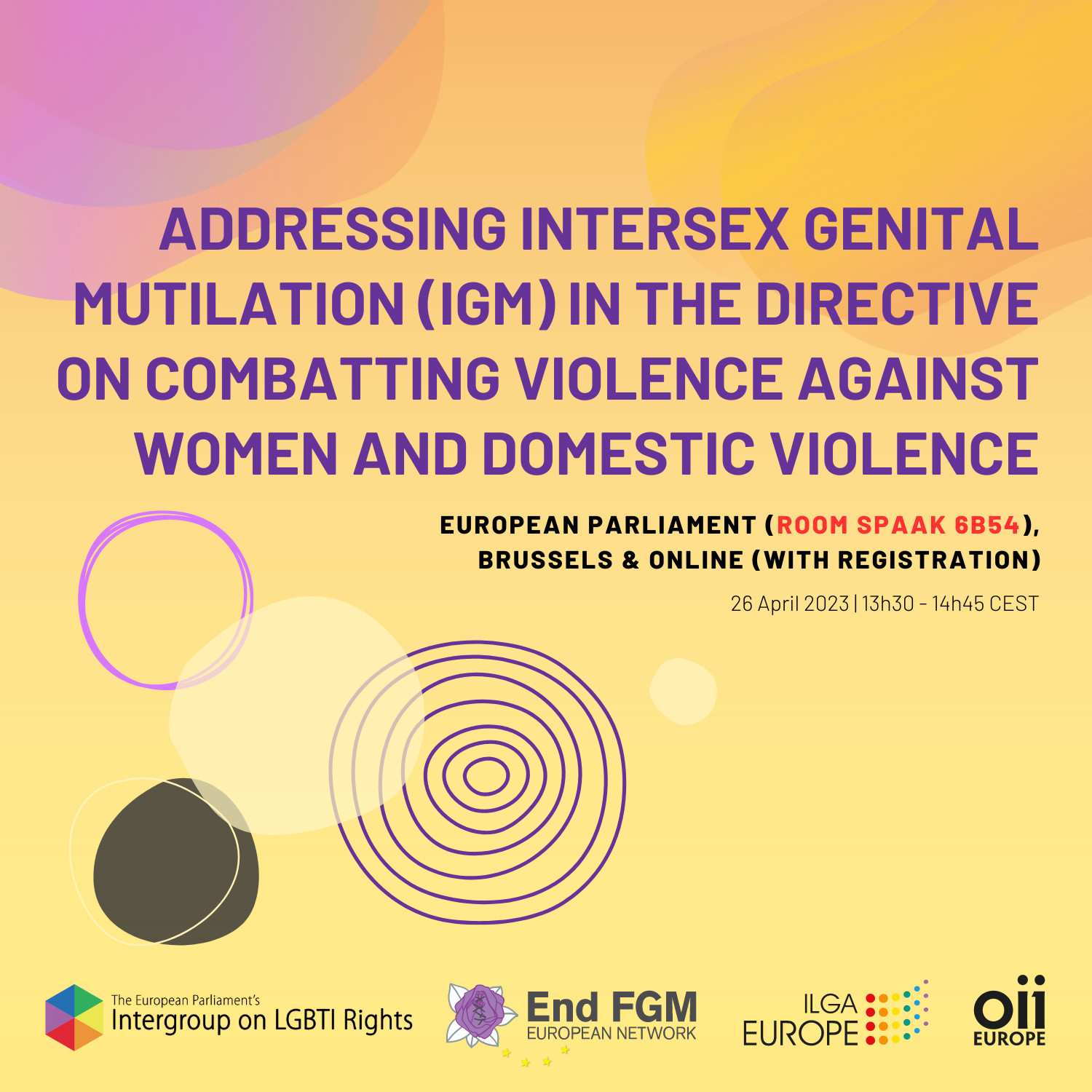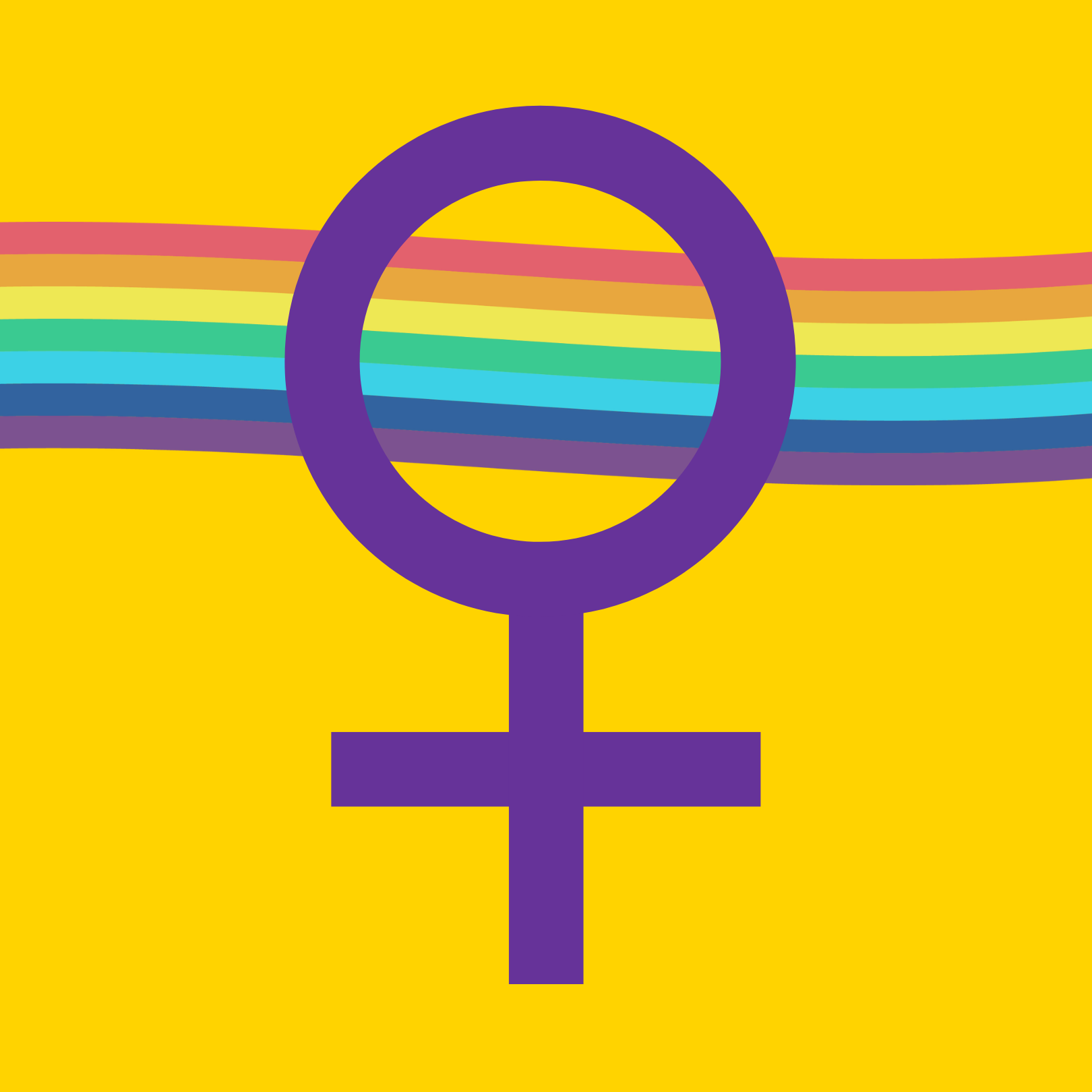On May 7th 2024, the EU Member States adopted1 the Directive on combating violence against women and domestic violence, following adoption in Parliament on April 24th2.

For over 2 years, OII Europe has been closely following the legislative process, through, among others, the preparation of a submission3 to the European Commission in May 2022, participation in stakeholder consultations organised by the European Parliament FEMM and LIBE Committee rapporteurs and shadow rapporteurs, as well as an event4 at the European Parliament in April 2023 co-hosted MEP Malin Bjork & MEP Marc Angel, and co-organised by OII Europe, EndFGM European Network & ILGA Europe.
We welcome the fact that the Directive – the first binding EU legislation on the matter – advances the protection of women and girls in the EU from some forms of gender-based violence, in particular from some forms of cyberviolence, female genital mutilation and forced marriage.
Notably, it is also the first time in history that intersex people are explicitly recognised as being among the victims who are at a heightened risk of experiencing violence due to intersectional discrimination they face (recital 56 & recital 58). This explicit recognition marks an important standard setting moment within the framework of binding EU legislation.
As OII Europe previously highlighted in a statement5 on February 8th, it is deeply disappointing to note that the Directive fails to include all victims of gender-based violence within its scope and therefore leaves significant gaps in protection within the EU. We strongly regret that the proposal by the European Parliament to criminalise intersex genital mutilation (IGM) alongside female genital mutilation (FGM), as well as forced sterilisation of women and girls, was deleted by the Council.
As a result of a lack of political will from some Member States, the final text fails to include an explicit Article related to criminalisation of rape based on lack of consent. Furthermore, it falls short of explicitly ensuring protection and support for victims at a heightened risk of violence, such as LGBTI victims and undocumented women.
However, intersex people, while not explicitly mentioned throughout the Directive text, will be able to benefit from the provisions related to the recognition of the right of all victims to benefit from protection, access to justice, victim support & prevention (recital 5); recognises that people experiencing intersectional discrimination are at a heightened risk of experiencing violence (recital 11); recognises the severity of mutilative practices (recital 16); recognises incitement to violence online (recital 22); recognises the need to take appropriate preventive measures (recital 58).
In this analysis, we elaborate on the specific ways in which intersex people who are victims of gender based violence will be able to benefit from the aforementioned provisions, if and when transposed and correctly implemented at national level.
Recognition of the right of all victims to benefit from protection, access to justice, victim support & prevention:
The Directive on combating violence against women and domestic violence finds its legal basis in Article 83(1) of the Treaty on the Functioning of the European Union (TFEU), which includes the area of crime “sexual exploitation of women and children”. The Directive therefore is limited in its scope of the specific forms of violence it explicitly recognises as forms of gender-based violence, and primarily serves to address the specific needs of women and girls . However, it is positive that in recital 5 of the Directive, we see recognition of the fact that “the term ‘victim’ should refer to all persons, regardless of their gender and, unless specified otherwise in a given provision, all victims should benefit from the rights related to the protection of victims and access to justice, victims support and prevention.”
The comprehensive application of this provision, and the inclusion of all victims, including intersex victims, no matter their gender, will depend on each Member State.
Recital 5
The measures under this Directive have been designed to address the specific needs of women and girls, given that, as confirmed by data and studies, they are disproportionately affected by the forms of violence covered under this Directive, namely violence against women and domestic violence. However, other persons also fall victim to these forms of violence and should therefore also benefit from the same measures provided for in the Directive for victims. Therefore, the term ‘victim’ should refer to all persons, regardless of their gender and, unless specified otherwise in a given provision, all victims should benefit from the rights related to the protection of victims and access to justice, victims support and prevention.
Recognises that people experiencing intersectional discrimination are also at a heightened risk of experiencing GBV:
Intersex people face multiple and intersecting forms of discrimination, which can be based on a combination of different grounds, such as sex characteristics, sexual orientation, gender identity and/or expression, among others. The Directive includes an open-ended list of grounds upon which discrimination can be based in recital 11. The list includes sex and sexual orientation, and is based on the list of non-discrimination grounds of Article 21 TFEU. However, as mentioned above, the list is open ended, and can therefore be interpreted as encompassing other grounds than the ones explicitly listed. Case law from the European Court of Justice (CJEU), for example, has already supported a broad interpretation of the ground of “sex” to include the ground of sex characteristics in the past. Furthermore, recital 11 goes on to explicitly say that all “persons affected by intersectional discrimination are at a heightened risk of experiencing gender-based violence”. This is an important recognition of the need for Member States to ensure that the measures they implement under this Directive, take into consideration this heightened risk – particularly as regards the individual assessment which serves to identify victims’ specific protection needs, as well as the kinds of specialist support that intersex victims of gender-based violence may require, as outlined in recital 56, where we have the explicit mention of intersex persons among LGBT persons.
Recital 11
Violence against women and domestic violence can be exacerbated where it intersects with discrimination based on a combination of sex and other grounds of discrimination referred to in Article 21 of the Charter, namely race, colour, ethnic or social origin, genetic features, language, religion or belief, political or any other opinion, membership of a national minority, property, birth, disability, age or sexual orientation. Member States should therefore pay due regard to victims affected by such intersectional discrimination by taking specific measures. Persons affected by intersectional discrimination are at a heightened risk of experiencing gender-based violence. Consequently, Member States should take that heightened level of risk into consideration when implementing the measures provided for by this Directive, especially regarding the individual assessment to identify victims’ protection needs, specialist support to victims and training and information for professionals likely to come into contact with victims.
Recital 56
Victims experiencing intersectional discrimination are at a heightened risk of violence. These may include women with disabilities, women with dependant residence status or permit, undocumented migrant women, women applicants for international protection, women fleeing armed conflict, women affected by homelessness, with a minority racial or ethnic background, living in rural areas, women in prostitution, women with low income, detainees, lesbian, gay, bisexual, trans or intersex persons, older women or women with alcohol and drug use disorders. They should consequently receive specific protection and support.
Recognises that the severity of mutilative practices
Recital 16 of the Directive focuses on female genital mutilation (FGM), which is a harmful practice against women and girls that shares many similarities with intersex genital mutilation (IGM). Under the Directive, female genital mutilation is recognised as a criminal offence, while intersex genital mutilation is not. However, the fact that the definition of FGM in recital 16 is defined as covering “all mutilative practices undertaken for non-medical reasons, which cause irreparable and lifelong damage on victims,” as well as the fact that “it leads to psychological and social damages, which severely affect the victims’ quality of life,” are a big step forward. Although we have no explicit recognition in this provision of IGM, the recognition that mutilative practices performed for non-medical reasons – as is the case with IGM – causes irreparable and lifelong damage, paves the way for future recognition of victims of IGM as suffering the same harm and damages as victims of FGM.
In its report6 adopted on 12 July 2023, the European Parliament included an Article (6a) criminalising the practice on intersex genital mutilation, by stipulating that “Member States should ensure that the following intentional conduct is punishable as a criminal offence: performing any medically unnecessary surgical or medical procedure or hormonal treatment on the sex characteristics of a healthy woman or child born with variations of sex characteristics, without obtaining prior and informed consent and without the woman or child understanding the procedure or treatment, with the purpose or effect of altering those sex characteristics to align them with sex characteristics considered typically female or male;”. Unfortunately this proposal was not taken on board by the Council, and the Article fell away during the interinstitutional negotiations.
The opinion7 by the Council Legal Service of 31 October 2022 which comments on the Directive’s legal basis as well as its compatibility with the principle of non-discrimination, in paragraph 22, states that “Article 83(1) […] cannot be interpreted as ensuring only partially the protection provided by the Charter and the Treaties in this field, and giving the EU co-legislators the competence to establish, only with regard to one sex, minimum rules concerning the definition of a criminal offence by which, by its very nature, affects the sexual integrity and the human dignity of all persons regardless of their sex.” This recognition by the Council’s legal service is important, as it paves the way to allow for it to be argued that intersex victims of harmful and exploitative practices such as intersex genital mutilation – which severely impacts their sexual integrity, as well as their human dignity, should not be discriminated against because of their sex.
In this legal opinion, we also find, in paragraph 47, the very important explanation that when it comes to interpreting broadly the legal basis of this Directive – Article 83(1) TFEU “sexual exploitation of women and children” – that “a more nuanced approach may be justified for the crime of female genital mutilation, in so far as genital mutilation is a practice that could be narrowly linked to forms of exploitation of minors. It could be argued that it contains an exploitative element, in so far as it affects, to a large effect, the vulnerable situation of minors and could thus be interpreted as falling within the scope of ‘sexual exploitation of children’.” Again here we see a very important recognition by the legal service of the exploitative element that underpins genital mutilation, which is largely performed on minors and in the case of intersex minors – often on infants and very young children.
Recital 16
A directive shall be binding, as to the result to be achieved, upon each Member State to which it is addressed, but shall leave to the national authorities the choice of form and methods. However, given the special nature of the offense of female genital mutilation, and the need to ensure the protection of victims who suffer specific damage, this offence should be specifically addressed in the criminal laws of the Member States. Female genital mutilation is an abusive and exploitative practice that pertains to the sexual organs of a girl or a woman and that is performed for the purpose of preserving and asserting domination over women and girls and exerting social control over girls and women’s sexuality. It is sometimes performed in the context of child forced marriage or domestic violence. Female genital mutilation may occur as a traditional practice which some communities perform on their female members. It should cover mutilative practices undertaken for non-medical reasons, which cause irreparable and lifelong damage on victims. It leads to psychological and social damages, which severely affect the victim’s quality of life. The term “excising” should refer to the partial or total removal of the clitoris and the labia majora. “Infibulating” should cover the closure of the labia majora by partially sewing together the outer lips of the vulva in order to narrow the vaginal opening. The term “performing any other mutilation” should refer to all other physical alterations of the female genitals.
Recognises incitement to violence online
One of the largest topics covered by the Directive are the various forms of online violence which impact women and girls such as cyberflashing and online sexual harassment and bullying. While the Directive does not comprehensively cover all forms of online violence, it does recognise the urgency in tackling the sharp rise in online incitement to violence and hatred, and the ways in which these forms of sexist and misogynistic forms of violence translate into in-person hate crimes and hate speech. Importantly, in recital 22, it is made clear that incitement to violence is not always directly linked to “the gender of the targeted person(s), but [that] the bias motivation can be inferred from the overall content or context of the incitement”. For intersex persons, who may be the target of online violence due to their sex characteristics, in combination with other grounds, this recognition is an important step in giving visibility to the underlying bias motivation upon which these forms of violence are based and perpetuated.
Recital 22
The increase in internet and social media usage has led to a sharp rise in public incitement to violence and hatred, including based on gender, over the past years. The easy, fast and broad sharing of hate speech through the digital word is reinforced by the online disinhibition effect, as the presumed anonymity on the internet and sense of impunity reduce people’s inhibition to engage in such speech. Women are often the target of sexist and misogynous hate online, which can escalate into hate crime offline. This needs to be prevented or intercepted at an early stage. The language used in this type of incitement does not always directly refer to the gender of the targeted person(s), but the biased motivation can be inferred from the overall content or context of the incitement.
Recognises the need to take appropriate preventive measures
The Directive makes explicit reference to the need for Member States to ensure that appropriate preventive measures and related targeted actions take into consideration groups at a heightened risk, including intersex persons (recital 58). Acknowledging intersex persons as a specific group in this list of other groups of victims at a heightened risk, gives visibility to the need and importance of tackling the root causes of violence directed towards intersex persons, by means of awareness raising campaigns and other targeted measures. We highly welcome this intersex-inclusive provision.
IGM is a form of gender-based violence because it is performed with the purpose of making the body of a child with a variation of sex characteristics fit the medical and societal norms of what is understood to be a typical female or male body – including its appearance, function and the expression of the future adults’ sexuality. Harmful gender stereotypes are enacted through violent, harmful practices which aim to exert social control over the intersex child’s and young adolescent’s body and sexuality. IGM performed on children, in particular but not limited to intersex children assigned female, also present some specificities and evident connections with other forms of violence against women and girls such as female genital mutilation (FGM)8. What lies behind the assumptions that motivate IGM is the very same misogynist mindset that leads to intimate partner violence, rape and other forms of violence against women and girls.
Recital 58
Member States should take appropriate preventive measures. Such measures may include awareness-raising campaigns, to counter violence against women and domestic violence. Prevention may also take place in formal education, in particular, through strengthening sexuality education and socio-emotional competencies, empathy and developing healthy and respectful relationships. Taking into account language barriers and different levels of literacy and abilities, Member States should address targeted actions to groups at heightened risk, which include children, taking into account their age and maturity, persons with disabilities, persons with alcohol and drug use disorders, and lesbian, gay, bisexual, trans or intersex persons.
We recognise that the Directive only sets minimum standards and that its adoption is merely the first step in a long process of working with Member States to ensure they aim much higher in their implementation of these standards at national level. We warmly welcome the explicit inclusion of intersex persons in the text of the two above-mentioned recitals of this Directive, and hope that in the near future, all relevant provisions aimed at combating diverse forms of gender-based violence will be intersex-inclusive.
OII Europe, alongside other LGBTI-, women’s rights- and human rights organisations have worked together in a coalition over the last year to advocate9 for a stronger, broader range of demands to be covered by the Directive. We will continue to fight for better binding legislation at EU level that ensures comprehensive protection, support and justice for intersex victims and survivors of gender-based and domestic violence. Once the Directive has entered into force, EU Member States will have 3 years to implement the various provisions laid out in the text. In Article 45 of the Directive, following an eight year period from the date of entry into force of the Directive, it is specified that the European Commission will carry out an evaluation of the impact of the Directive by submitting a report to the European Parliament and the Council. The Article further states that this report, “shall assess, in particular, whether an extension of the scope of this Directiveand the introduction of new offences is necessary. The report shall be accompanied by a legislative proposal, if necessary.” Over the next eight years, OII Europe firmly commits to continue raising awareness among EU Member States about the specific forms of gender-based violence that intersex people are at a heightened risk of experiencing and about the impacts of the harmful practice of intersex genital mutilation. We will continue supporting and working with our member organisations to follow up on transposition and implementation of the Directive at national level, and to ensure that awareness of these issues continues to be raised among national policy-makers.
****** END *****
Footnotes:
- https://www.consilium.europa.eu/en/press/press-releases/2024/05/07/council-adopts-first-ever-eu-law-combating-violence-against-women/?utm_source=brevo&utm_campaign=AUTOMATED%20-%20Alert%20-%20Newsletter&utm_medium=email&utm_id=320 ↩︎
- See Joint statement by OII Europe, Amnesty International, Center for Reproductive Rights, EL*C, End FGM European Network, ESWA, Human Rights Watch, ILGA-Europe, IPPF EN, La Strada International,PICUM, TGEU and WAVE, from May 7th 2024 following the adoption of the Directive. ↩︎
- https://www.oiieurope.org/submission-combating-violence-against-women-and-domestic-violence/ ↩︎
- https://www.oiieurope.org/video-event-directive-vaw-dv/ ↩︎
- https://www.oiieurope.org/statement-on-the-political-agreement-on-the-vaw-and-dv-directive/ ↩︎
- https://www.europarl.europa.eu/doceo/document/A-9-2023-0234_EN.html#_section1 ↩︎
- https://data.consilium.europa.eu/doc/document/ST-14277-2022-INIT/en/pdf ↩︎
- See Ghattas, D. C. (2019). Protecting Intersex people in Europe. A toolkit for law and policy makers. With digital Appendix and Checklist. ILGA-Europe and OII Europe, p. 12. Available from https://oiieurope.org/library-en/toolkit-cat/legal-toolkit/ ↩︎
- https://www.oiieurope.org/joint-statement-of-civil-society-organisations-on-the-eu-directive-on-combating-violence-against-women-and-domestic-violence/ ↩︎

